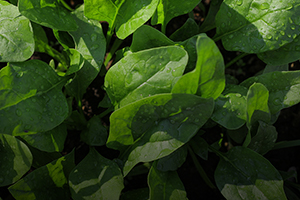Spinach Biosensor

Engineers at MIT are looking at ways to turn living plants into nanobionic sensors that can detect biological and environmental hazards and send a signal to alert farmers. One of them — a newly engineered spinach plant — can identify arsenic levels in soil more accurately than existing tools.
The technique uses inexpensive nanoparticles (50,000 times smaller than a human hair) embedded directly into the plants to act as sensors for a variety of chemicals, including hormones that are generated by the plant itself when it is stressed. Many of these compounds show up in the plant before the condition can be detected by visual inspection. The plants would be separated from food crops but placed in the same type of environment, and the nanoparticles can be programmed to generate a variety of electronic signals.
These new plants can also aid in developing new crop varieties by allowing researchers to directly measure what happens within the plants under changing climate conditions. They could even be turned into living light-emitters to illuminate areas that are off the grid.
For information: Michael Strano, Massachusetts Institute of Technology, Department of Chemical Engineering, 77 Massachusetts Avenue, Cambridge, MA 02139; phone: 617-324-4323; fax: 617-258-8224; email: strano@mit.edu; website: MIT - Massachusetts Institute of Technology or Strano Research Group – Department of Chemical Engineering at MIT